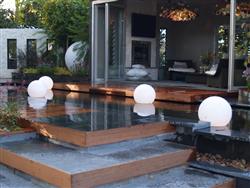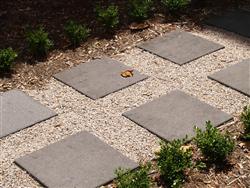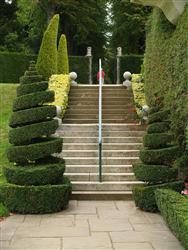Pavers, Concrete, Stone, Gravel Surfaces
USING PAVERS, CONCRETE, STONES AND GRAVEL
Paths, driveways, terraces and outdoor living areas are commonly surfaced with either gravel, concrete, asphalt, pavers or some other hard material.
 Why Surface the areas?
Why Surface the areas?
-
So you can walk on them when wet without slipping or getting dirty.
-
So they don't erode.
-
So they will take heavier traffic (eg: surfacing may be necessary to prevent cars getting bogged in the driveway).
-
For aesthetics (so they look better).
-
To control weed growth.
-
To provide a hard, even surface for play or entertainment. Where should you use hard surfacing materials?
-
Joining two areas which you move between frequently, such as a driveway between the front of the property and the garage, a path between the laundry and washing line, a path between the house and tool shed, or a path between the garage and house.
-
On areas which are used for outdoor living or entertaining. These areas generally get more foot traffic than other parts of the garden, and need to withstand heavy use. Lawn might be damaged too much.
-
On areas used for certain games (eg: for skateboarding, riding bikes, ball games).
-
In service areas to provide an even, hard surface that is easily cleaned.
 PAVING
PAVING
Paving is the use of sections, such as blocks or slabs, of solid materials to create a hard surfaced area. This may be in the form of a pathway which links together the various parts of your garden, as a driveway, as the floor in covered areas such as sheds, carports or wine cellars, or for work, play or entertainment areas (both open and closed). They should provide a surface that is well drained, ideally low in maintenance, preferably attractive, and above all safe to use.
Materials used in paving
These range from precast‑concrete pavers, to slate pieces, to rounded pebbles or small rocks, to blocks of wood, to bricks and many more. Some of the more commonly used materials are discussed below:
Bricks ‑ Kiln fired clay bricks are one of the most common types of paving materials. Some types of bricks have a hollow or indented area in one or more sides which means that the bricks can't be laid that side up. Bricks can be obtained in a variety of textures and colours. They are generally rectangular in shape. In Australia the majority of bricks produced are around 227mm (9 inches) long by 109mm (4.25 inches) wide and 75mm (3 inches) deep. Some types of solid house bricks can be readily used as pavers, with second-hand house bricks often being used in this role, however brick manufacturers now produce bricks specifically as pavers. These are designed to withstand conditions such as frequent use, and heavy loads such as vehicles, and are available in various sizes.

Concrete pavers ‑ These have become very popular in recent years. They are available in a variety of shapes and sizes ranging from the traditional square types through to L‑shaped, octagonal and various interlocking types. Colours typically range from the natural cement colouring to browns, greys and pinks.
Slate ‑ This is usually thinner in depth and generally less hardy than the other types of pavers. It requires a solid base to reduce damage, particularly from heavy loads. Slate is very variable in price with imported varieties generally more expensive than local types. It is often sold as irregularly shaped pieces and can therefore be harder to piece together into a closely fitting pattern than the more regularly shaped pavers. Extensive cutting of pieces may be required. Slates can have very attractive colouring and patterning and are most commonly used in entertainment areas, both indoor and outdoors.
Natural rocks ‑ a) cut sections (ie: bluestone pitchers), or b) cobblestones (ie: rounded river pebbles). These are less common than brick or concrete pavers. Such materials are generally not as readily available as are bricks or concrete pavers. They can also can be fairly expensive, as in the case of blue stone pitchers. Such rocks can provide an attractive hard wearing surface but they tend to be a bit uneven. They can be fixed in position by carefully "locking" them together straight into a bedding mix of sand, or preferably fixed more solidly in a mortar base.
Wood ‑ (eg: tramway blocks). Wood blocks can come in many shapes and sizes. They provide a softer surface than other types of pavers. Lifespan of the blocks depends on the type of wood used. Some river red gum (Eucalyptus camaldulensis) blocks have lasted in excess of 50 years and are still in good condition. These blocks can often make a very attractive addition to informal type areas such as Australian Bush Gardens. They can also be a lot easier to cut to required shapes than the other types of pavers. They may tend towards to warping, particularly if the timber is unseasoned, and they can get very slippery in moist areas, particularly if they become coated with mosses and similar plants.
|
SELECTION OF MATERIALS:
The type of paving material that you select will generally be based on such factors as:‑
i) Cost ‑ This will vary considerably from material to material for example imported slate may cost a great deal more than locally derived slate.
|
STUDY
LANDSCAPE CONSTRUCTION or
GARDEN DESIGN
Click to see our Courses
|
SELECTING MATERIALS
Select the type of paving material based on the following factors:
Cost -This varies a lot between materials and also distance from supply. Local materials may be cheaper, because transport costs are cheaper.
Availability - Some materials may be readily available in your area, others not. This is also closely linked to cost. Materials may be available but only at high cost because they may have to be transported to your area. Second hand material may need to be cleaned up prior to use.
Appearance‑ Each material has it's own distinctive appearance, particularly in terms of colour and texture. Some have smooth polished surfaces (e.g.slates), some have a rough coarse surface (e.g. brushed concrete pavers), some have attractive patterns (e.g. slate and many types of bricks), while others have a consistent colouring (e.g. some concrete pavers).
Ease of laying ‑ Some materials, such as slate may require shaping or cutting before being used, some may require a mortar base while others may, not. Some materials, such as bluestone pitchers, may be very heavy to handle.
Use ‑ If the paved area is going to be used for frequent traffic or heavy loads then you will need to use pavers that are capable of withstanding those pressures. Footpaths and swimming pool surrounds require a non-slip finish, while sloped areas may require a coarse enough texture to provide grip, while for other areas that are frequently swept clean a smoother surface may be required.
CONCRETE
Despite the distaste many people have for concrete, it remains probably the most popular surfacing material. It is relatively inexpensive, long lasting, and if laid properly, perhaps the easiest surface to maintain.
Concrete can be finished the following ways to create different effects:
-
Adding pigment to change the colour
-
Brushing the surface lightly with a stiff broom to create a non-slip surface.
-
Use of moulds to create cobblestone or other types of affects.
-
Stencilling patterns to mimic pavers, cobblestones, etc.
GRAVEL
Gravel is the least expensive way of surfacing a driveway or path. A good quality gravel is a mixture of stone chips with fine (dust-like) material. The dust-like material sets hard around the stones when wet and compacted, holding the stones in place and making a solid surface.
Hints
-
The path will be more solid and have a more even surface if a foundation is prepared in a similar way to a concrete path.
-
The path will settle quicker and better resist erosion if watered and rolled (or compacted) after laying.
-
You require at least 4cm depth for a permanent path or 8cm for a driveway.
-
The final level should be higher than the surrounding ground and sloped from the centre to the sides to allow good water runoff and prevent erosion along the length of the path.
ASPHALT
Asphalt is laid in much the same way as concrete. It is a mixture of stones and tar (or bitumen). Asphalt has several advantages over concrete:
-
It is a lot cheaper.
-
Damaged sections can be repaired much easier than concrete.
-
It is better on steep and uneven slopes than concrete (it doesn't slump while setting).
-
It sets much more quickly than does concrete (can be used earlier).
Disadvantages of asphalt include:
-
It is not as durable or hard wearing as concrete.
-
It can't be moulded or patterned like concrete.
-
The colour range is much more limited than for concrete.
LAYING PAVERS
For all types of pavers you need a solid base otherwise the pavers will rise or subside in line with the movement of the underlying material. This may cause the paved surface to become uneven, perhaps with protruding edges that may result in the area being unsafe to walk upon.
It may also result in depressions that will hold water.
Where underlying sediments are very soft or moist you may need to improve drainage such as the use of agricultural drains or to put down a layer of rubble or coarse material.
For most situations pavers are generally laid on a weak mortar base ie. 1 part cement to 4 parts sand or directly onto a soft sand base that has been levelled, firmed down, but not packed down too hard. When laying on sand you need to have some sort of border or edge, such as treated timber or a line of bricks set in mortar.
This will help hold the sand in position. This edge can be visible or buried just below the surface.
The sand should be tamped down ie. with a hand tamper or for larger areas by a roller.
Straight edges or wooden boards can be used to slide forward and backwards across the sand to get a level surface. The final sand layer should be around 50 - 75mm (2 to 3 inches) thick. The pavers should then be pressed securely in position on the sand or mortar base and tapped down level with a straight edge.
Consideration should be given to having a slight even slope to the finished surface to aid drainage. The gaps between the pavers can be filled with grout such as the 1 to 4 mortar mix used for bases. The excess grout should be wiped clean or brushed away with a stiff bristled broom.
When the paved area, however, is to be used for vehicle access or other heavy uses then you will need to lay the pavers on a more substantial base such as a 75mm (3 inch) layer of reinforced concrete.
CHECK OUT OUR LANDSCAPING COURSES (click here)
Want to Learn More?
Check out horticultural and landscaping publications in the ACS Bookshop: www.acsbookshop.com
For more information on Courses on Landscaping, Horticulture and Plants:
In Australia: http://www.acs.edu.au/Courses/horti.aspx
In the UK: http://www.acsedu.co.uk/Courses/horti.aspx
You may also be interested in....